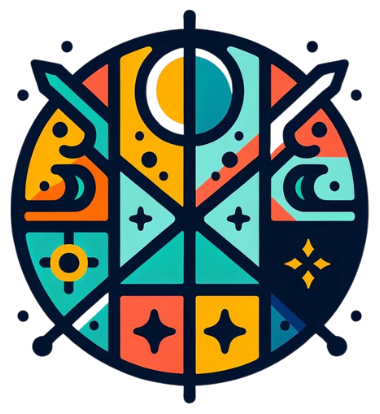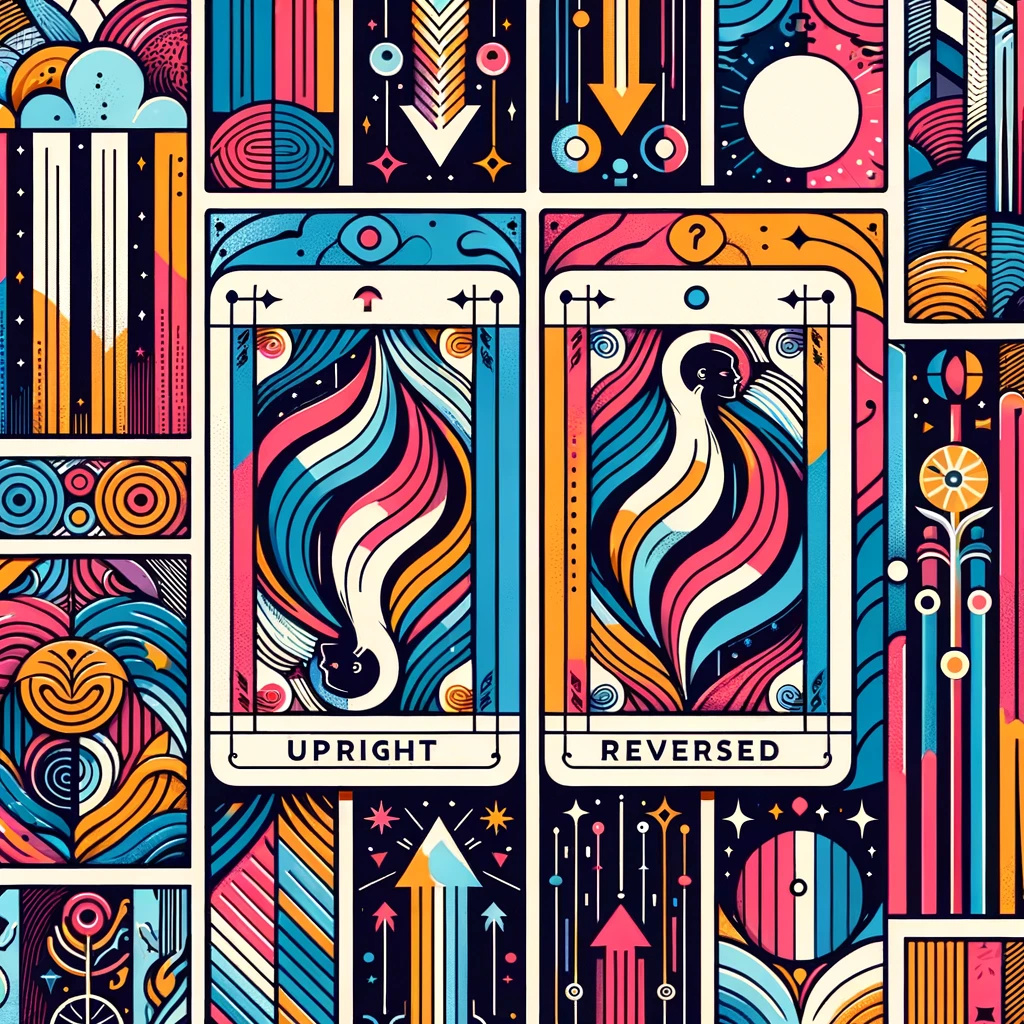If you’re just getting started in the world of tarot, you’ve probably heard that the meaning of your card changes whether it’s upright vs reversed. If not, a whole new world of interpretations has just opened up for you!
The orientation of a card (whether it’s upside down or right side up) plays a significant role in its interpretation. Each card in a tarot deck can appear in two ways: upright or reversed:
- Upright cards are generally perceived as manifesting outwardly, highlighting external influences or situations in your life.
- Reversed cards tend to reflect internal challenges, potential blockages, or aspects of a situation that require introspection.
Reversals can signal that you should pay attention to a specific area of your life, often hinting at aspects that are not as straightforward as they would be if the card was upright.
A common misconception of tarot readers is that reversed cards mean something negative. That’s not the case at all! And that’s actually what I thought when I was starting too (which is why I avoided reading reversals for a long time…)

When I first started reading tarot, the reversed cards intimidated me. To get around this, I just decided that even if a card came out reversed, I would read the interpretation upright to make it simpler.
This worked just fine for me for a long time. But once I was comfortable adding in reversals, it added a whole new layer of depth and different perspective to my readings.
So if you’re feeling comfortable, read on and and discover a whole new world of tarot card meanings!
Key Takeaways
- The orientation of tarot cards affects their meaning.
- Upright cards relate to external influences or situations in your life.
- Reversed cards suggest internal reflection or hint at aspects that are not as straightforward
Understanding Tarot Card Orientations
The way your cards are faced when you lay them out in your spread plays an important role in how the cards are interpreted. In traditional tarot, the orientation influences the energy and message of the reading.
Upright vs Reversed Tarot Positions
When you draw a tarot card and it’s facing up, it’s considered “upright“. The upright meaning of the card represents the meaning traditionally associated with the card. It can also reflect situations and feelings that are manifesting externally in your life.
Conversely, a reversed tarot card (or upside-down card) often suggests an inward focus although it’s not an exact science. Reversed cards might hint at one of the following:
- Internal issues or something that’s an inward focus
- The opposite meaning of the upright meaning of the card
- Signalling a delay or blockage in the situation at hand
It can seem a little complicated at first. But from my experience, the more you get comfortable reading your tarot spread, the more you will begin to develop a strong intuitive sense of which interpretation and message your reversed card is leaning toward.
Orientation and Energy of the Cards
The orientation of the cards affects the flow of energy in a reading.
For instance, having mostly upright cards can suggest a straightforward flow, where energies are aligned and outwardly expressed.
On the other hand, when you see reversed cards in your spread, this could point to a more complex situation. In this instance, you would want to interpret your spread from the lens of seeing where energies may be introspective or stagnant.
It’s important to consider both the position of the cards and your intuition to grasp the full scope of the message.
Interpretations of Upright Tarot Cards
As mentioned above, the upright tarot cards reflect the core meanings and symbols of each card in a tarot deck. They signify the situation or emotions as they manifest openly in your life.
Common Meanings and Symbols
Each upright card has distinct symbols and narratives that convey unique messages. The upright meanings often represent positive aspects, such as growth, success, or joy. For example, The Fool signifies a new beginning or an adventure, reflecting optimism and spontaneity.
Applying Upright Meanings in Readings
When you draw a card upright, it suggests a clear and straightforward effect on your life. It’s important for you to connect the card’s imagery and symbols to your specific situation. You should consider how the upright position could symbolize external influences or actions in the material world.
Take for instance the 7 of wands. In the upright position, this card could symbolize external influences or actions in the material world, such as a need to assert yourself, defend your position, or stay true to your convictions in the face of external opposition.
Upright Cards in Different Spreads
Upright cards can shift in significance based on their placement in a spread. In a past-present-future spread, for instance, the upright Empress in the past position could indicate a period of nurturing and abundance that has set the foundation for your current circumstances.
Reversed Tarot Card Dynamics
When you start to include reversed cards in your readings, you will see how it significantly deepens your tarot readings. Here’s how they impact meanings, relevance, and energy flow.
Exploring Reversed Meanings
A reversed position in a tarot deck isn’t simply the opposite of its upright counterpart. It often signals a subtle or latent energy that requires your attention.
Let’s go back to the 7 of wands example that we used above and see how we can interpret this card in the reversed placement.
When reversed, the 7 of Wands card can point to internal conflicts, feelings of being overwhelmed, or the internalization of the struggle to stand your ground.
Unlike the upright position, which emphasizes external challenges and the action required to confront them, the reversed Seven of Wands suggests a need to reflect on internal barriers and fears that might be preventing you from asserting yourself or standing up for your beliefs.
Contextual Relevance in Reversals – The Reversed Empress as an Example
The context of the card plays a crucial role in interpreting a reversal. Make sure you’re taking a step back to how the cards relate to both the question and the current circumstances.
If you pull a reversed Empress card in a romantic relationship reading, you may interpret it as the opposite meaning of the upright interpretation of the card.
In this situation, it could indicate issues related to imbalance in care and nurturing. One partner may feel neglected or overburdened with providing emotional support. The reversed Empress calls attention to the need for self-care and mutual nurturing, suggesting that the relationship may benefit from open communication about emotional needs and desires to ensure both partners feel valued and cared for.
Alternatively, if you pull a reversed Empress card in a personal growth reading, you may interpret it from the perspective of an inward focus.
In this situation, the Empress reversed might highlight a disconnection from one’s own needs, particularly in terms of self-love and self-care. This context suggests an inner journey to reconnect with what truly nurtures your soul and brings you joy. It could be a sign to prioritize your well-being and to cultivate a more nurturing and compassionate relationship with yourself.
Seeing a reversed ‘High Priestess’ during a period of confusion might indicate that your intuition is blocked or that private matters are yet to surface.
Always consider the question and circumstances of the reading. It’s like putting all the puzzle pieces together to see what makes sense 🕵️
Impact of Reversed Cards on Energy Flow
Reversed cards can hint at imbalances or stagnant energy flows which can be valuable to pinpoint areas for personal growth. A reversed ‘Wheel of Fortune’ might suggest that a cycle in your life is stuck and needs a push to regain movement.
See how much insight reversals can bring to your readings?!
Shuffling Techniques to Get Upright and Reversed Cards
When you’re shuffling your cards, there are several techniques you can use to ensure a mix of upright and reversed cards. The goal is to introduce variety into the orientation as you prepare for a reading.
| Technique | Action | Result |
|---|---|---|
| Overhand Shuffle | Rotate and mix portions of the deck. | Random reversals during a reading. |
| Cut the Deck | Split the deck into piles, then restack alternately. | Controlled, yet spontaneous card flips. |
| Casino Style | Spread cards facedown and mix them around thoroughly. | A blend of card orientations. |
The Overhand Shuffle: This method involves holding the deck in one hand, then using the other to cut the deck and mix the cards. You can create reversed cards by rotating a portion of the deck before merging it back together. This technique allows for random reversals throughout the deck.
Cutting the Deck: Here, you slice the deck into several piles, flipping some upside down before restacking. This approach lets you control how many cards might appear reversed yet still provides an element of surprise.
Casino Style: In this shuffle, cards are spread facedown on a surface and mixed around. You can then scoop them up, resulting in a natural variety of reversed and upright cards.
Remember to shuffle with intention, focusing on your question or the situation requiring insight. I like to repeat the question I’m asking to make sure it’s clear in my head. I also like to visualize the spread that I’m going to do while I’m shuffling.
Your shuffling method sets the stage for a meaningful and insightful tarot reading.
Interacting with Tarot Readings
In tarot readings, the way you engage with the cards can transform a simple spread into a path of discovery for personal growth. Your approach, questions, and reflections all play critical roles.
Asking the Right Questions
To connect with your tarot spread, start with clear and focused questions. They should be open-ended to allow for exploration but specific enough to give your reading direction. Think about what you truly want to discover, instead of seeking yes or no answers.
I always find that the clearer my question is, the more accurate my readings are. One tip I learned along the way is to jot my question down on a piece of paper. Writing it down helps me get really clear on what I want to know.
Incorporating Intuition and Knowledge
As a tarot reader, it’s very important to trust your intuition. Every card and position in a spread holds unique significance, and your personal insights add value.
This is why I’m such a huge proponent of your learning tarot for yourself rather than putting that power in the hands of someone else. You know your situation best and the more you hone your intuition, the more you will be able to have that gut instinct on what messages are coming through.
As you recognize the patterns and narratives within the cards, you’ll be able to blend your knowledge of tarot symbolism with your instinctive understanding.
Reflection and Personal Growth
Use your readings as a mirror for reflection. Examine the upright and reversed meanings of the cards you draw to reveal different layers of your circumstances.
This contemplation can become a powerful tool to help guide you toward personal growth while encouraging introspection and self-awareness.


No responses yet